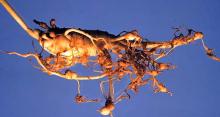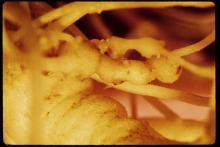Cause The root-knot nematode, Meloidogyne hapla, does not penetrate to the interior of the root, but remain just beneath the surface. Galled roots are reduced in value.
Symptoms Leaf symptoms are typical of nonspecific stress such as generalized chlorosis, slight stunting, and premature reddening or yellowing.
Galls on primary and secondary roots are conspicuous. On secondary roots, galls are two to three times the diameter of the root on which they grow. The galls when fresh are the same color as the roots but turn amber and then brown with age.
Sampling Before planting, take soil samples with sufficient lead time to implement management procedures if necessary. For example, after soil fumigation, it may be several weeks before crops can be seeded. Fall sampling for planting in the following spring is an excellent strategy. When sending samples to diagnose a suspected root-knot problem, it is best to include roots as well as soil.
Cultural control
- Do not plant on ground known to be infested with root-knot nematodes.
- Do not transplant roots with galls on them.
- Do not allow drainage from an infested field into a clean field or bed.
- Rotate to a grass or grain crop for 2 to 3 years. Keep weeds out; they may act as hosts for the nematode.
Chemical control
- Preplant fumigation.
- Telone II. 5-day reentry. Rates depend on planting depth and soil type; see label for details. Restricted-use pesticide.
Reference Putnam, M. 1989. Pathogens. In: Ginseng: A Concise Handbook. Algonac, MI: James A. Duke Reference Publications, Inc.



